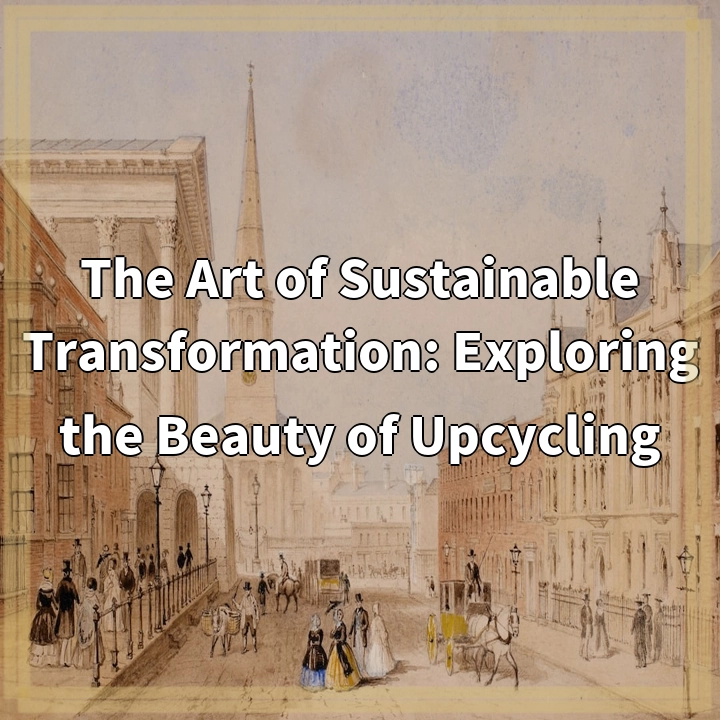
What is Upcycling?
Upcycling is a creative and innovative process that involves transforming waste materials or unwanted items into new products of higher value or quality. Unlike recycling, which often breaks down materials to create new ones, upcycling aims to retain the original form and characteristics of the discarded item while improving its functionality or aesthetic appeal.
Exploring the Beauty of Upcycling
Upcycling offers a multitude of benefits, both for individuals and the environment. It encourages sustainable practices by reducing waste, conserving resources, and minimizing carbon emissions associated with the production of new materials. Additionally, upcycling promotes creativity and self-expression, allowing individuals to repurpose items in unique and artistic ways.
Unleashing Creativity
Upcycling opens up endless possibilities for creativity and innovation. It allows individuals to repurpose materials in imaginative and unconventional ways, leading to unique and one-of-a-kind creations. By tapping into their creative potential, people can transform ordinary objects into functional or decorative pieces, breathing new life into otherwise discarded items.
Reducing Waste
The volume of waste generated worldwide poses a significant threat to our environment. Upcycling helps reduce this waste by reusing and repurposing materials that would otherwise end up in landfills. By giving new life to discarded items, upcycling helps conserve resources and alleviates the strain on our planet’s limited resources.
Promoting Sustainability
Upcycling promotes sustainable consumption by encouraging individuals to rethink their relationship with material possessions. Instead of constantly buying new products, upcycling provides an avenue to reuse and repurpose existing ones. This mindset shift can help reduce the demand for resource-intensive manufacturing processes, leading to a more sustainable future.
Real-World Problems Associated with Upcycling
Lack of Awareness
One of the challenges faced by upcycling is a general lack of awareness and understanding. Many people are still unfamiliar with the concept and the potential it holds. There is a need for more education and outreach to raise awareness about the benefits of upcycling and inspire individuals to incorporate it into their daily lives.
Access to Materials
Access to suitable materials for upcycling can be a hurdle for many individuals. While some discarded items can be easily repurposed, others may require specific materials or resources. Ensuring a steady supply of materials that are safe to upcycle and readily available is crucial for expanding the practice of upcycling on a larger scale.
Perceived Difficulties
Some individuals may avoid upcycling due to perceived difficulties or lack of confidence in their creative abilities. Overcoming these barriers requires promoting the idea that upcycling is accessible to everyone, regardless of their artistic skills or previous experience. Encouraging and providing resources for individuals to learn and improve their upcycling techniques can help break down these barriers.

Solutions to the Real-World Problems of Upcycling
While there are challenges associated with upcycling, there are also viable solutions that can help overcome them and promote the practice on a larger scale.
Education and Awareness
Raising awareness about upcycling and its benefits is crucial in encouraging more people to embrace this sustainable practice. By educating individuals about the concept, providing examples, and sharing success stories, we can inspire a mindset shift towards upcycling as a viable solution to waste reduction and resource conservation.
Material Accessibility
To facilitate upcycling, efforts should be made to ensure a steady supply of suitable materials. This can be achieved through community initiatives, partnerships with local businesses, and improved waste management systems. By making discarded items readily available and accessible, more individuals can engage in upcycling and contribute to reducing waste.
Skills Development
Offering workshops, online tutorials, and resources for learning upcycling techniques can help individuals gain confidence and develop their creative skills. By fostering a supportive and inclusive community, we can empower people to explore their creativity and embrace upcycling as an accessible practice.
Collaboration and Networking
Creating collaborations and networks within the upcycling community can provide opportunities for sharing knowledge, resources, and ideas. Building a supportive network can not only foster creativity and innovation but also help address common challenges and find collective solutions.
Incentives and Recognition
Government and private sector initiatives can play a role in promoting upcycling by providing incentives and recognition for individuals and businesses engaged in the practice. This can include grants for upcycling projects, awards for innovative upcycled products, and partnerships with retailers to promote upcycled goods.
Advocacy and Policy Support
Advocacy efforts are vital to drive the adoption of upcycling at a systemic level. By engaging with policymakers and advocating for supportive policies and regulations, we can create an enabling environment for upcycling initiatives. Encouraging the integration of upcycling into waste management strategies and promoting sustainable procurement practices can further advance the cause.















